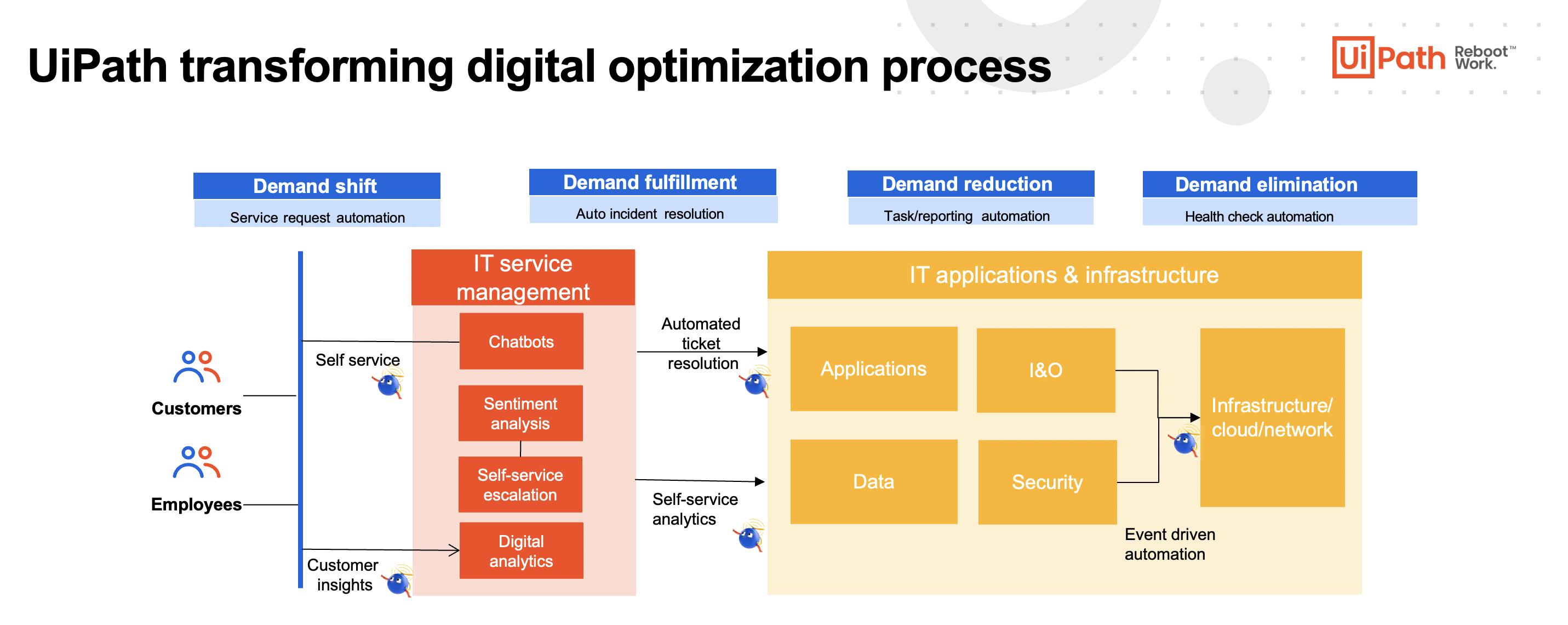COVID has impacted our lives to the maximum extent, but it has also acted as a catalyst for chief information officers (CIOs) in accelerating digital growth. In hindsight, what IT leaders have achieved during COVID is phenomenal. Quickly enabling remote capabilities for organizations and ensuring business continuity were daunting tasks which savvy CIOs achieved efficiently. Enabling new business models for the new normal through technology helped show IT as a strategic function in the organization rather than a mere operational function. However, this came at the cost of additional workload to IT teams.
IT operation activities have increased significantly due to an increase in service requests, cyberattacks, and the demand for new digital solutions. A recent Morgan Stanley Research report highlighted that IT spend and demand for digital growth and operational efficiencies will continue to sustain in 2022.
The key challenge for CIOs is always to balance the strategic alignment of growth and efficiency. Automation provides a critical path to achieving both strategies. When it comes to automation, UiPath has become a ‘one-stop shop’ for all automation needs, be it automating business processes, streamlining IT operations, improving the customer experience, or accelerating deployment of new digital solutions.
Achieving operational excellence
Achieving operational excellence involves utilizing workforce and assets efficiently, streamlining operational processes, and maximizing value to the customer at the lowest cost.

Service management
Our customers are automating contact centers, be it customer service or an internal IT helpdesk. Contact center automation enables customers to self-serve their needs. And automation delivers outcomes like reducing average handling time (AHT) and increasing first contact resolution rates. Self-service chatbots can resolve many service tickets, thereby reducing the number of tickets helpdesk agents manually review. UiPath robots can automate:
-
User management activities include onboarding/offboarding of employees, access/role changes, resetting passwords, blocking/unblocking users.
-
License management activities by optimizing the license usage and automating upgrades/downgrading license types based on the needs.
-
Asset management activities include maintaining inventory, usage, and integration with other solutions.
UiPath integrates with information technology service management (ITSM) tools used by clients and extends automation capabilities, especially in multi-platform environments.
IT operations
UiPath Platform automates IT operations fully by complementing and integrating existing operations and monitoring tools to achieve end-to-end automation. Your current performance monitoring tools may generate alerts but may not auto correct the root cause. Your IT ops team may get an alert or receive a ticket and need to perform actions manually. A UiPath bot can automate these activities by invoking remediations with pre-built actions based on alerts e.g.,
-
Infrastructure provisioning and orchestration
-
Backup and patch management
-
Cloud management
UiPath complements existing monitoring tools by enabling integration of these tools with any application or command-line interface (CLI) tools.
Security operations
UiPath automates security operations and risk management lifecycle by automating detect/prevent controls, testing, assessments, auditing, and remediation activities using event-driven automation and responses. Some of the security use cases examples implemented using UiPath include:
-
Security orchestration, automation, and response (SOAR)
-
Continuous policy controls testing for compliance audits
-
Automating security risk assessments
Data management
UiPath assists clients in various data management activities. Users can trigger UiPath automation through industry-leading data analytics platforms like Tableau and Qlik. Using UiPath Data Service, users can store business data in a centralized manner and use it across multiple automations. Some of the common data management use cases include:
-
Accelerate data extraction, publish and update system of record
-
Trigger and perform data enrichment activities
-
Automate data admin, cleaning, and preparation tasks
-
Automatically trigger workflows within data platforms
Accelerating digital transformation
Digital transformation is a broader strategic initiative involving people, processes, and technology. Organizations on their transformation journeys may have already optimized their existing operations. While transformation requires change management, company culture support, and new business models, one of the key components of digital transformation is developing new digital solutions.
Our clients are able to empower their agile teams by integrating their continuous delivery pipeline with UiPath, thereby accelerating various software lifecycle phases.

Preparation
The first challenge in any software project is to have a good understanding of how work gets done. Using a combination of UiPath Task Mining, UiPath Process Mining, UiPath Task Capture, and UiPath Automation Hub ensures you use both system data and employee expertise to identify impactful automation and transformation opportunities.
Recommended reading: A Simple Framework for Determining What Enterprise Processes You Should Automate
Development
Every development project requires new code development, creating/updating objects, code remediation, coding standards, etc. UiPath Marketplace offers more than 1,300 enterprise-grade reusable activity packs published by automation experts and practitioners from across the globe. These pre-built accelerators help expedite development efforts.
UiPath Integration Service
UiPath combines both best-in-class user interface (UI) automation capabilities with API automation capabilities—both accessible even in a single workflow. UiPath Integration Service offers a rapidly growing set of connectors to various popular platforms such as Salesforce, ServiceNow, Microsoft, Oracle, and many more. This enables customers to drive automations spanning one or more different line-of-business systems via API-based integration.
Simplified authentication and low-code/no-code tools empower developers.
Bonus: Find out how low-code strategies and tools are making CIOs more competitive.
Server-side triggers drive robots to take the next-step in near real time in order to successfully complete any automated business workflow.
Migration
There are various migration activities performed by developers during the development phase. In a typical cloud migration project, there are standard activities like virtual machine (VM) preparation, user management, policy configurations, lift and shift activities, network and security configurations. These activities can be expedited by using built-in wizards from UiPath. Similarly, UiPath accelerates data migration activities, especially when it comes to data validation and data mapping activities—migrations not easily feasible through extract, transform, and load (ETL) processes.
Continuous testing
Testing consumes a big chunk of time in any development project and is low-hanging fruit for automation. Test automation using UiPath not only accelerates the project testing activities but also automates the actual business process itself as the same scripts can also be used for the production process.
Our test suite of products integrate with test management and application lifecycle management (ALM) tools to provide end-to-end test automation. Using UiPath Test Manager, automated testing reduces the time to test workflows by more than three times and maintenance is minimized. Thorough testing reduces risks of production disruptions and frees up your RPA team to build new robots.
AI/ML-enabled automation
UiPath has artificial intelligence (AI) capabilities which allow developers to deploy, manage, and continuously improve machine learning (ML) models. And leverage those ML models within RPA workflows in UiPath Studio, enabling decision-making abilities in the processes.
With UiPath AI Center™, you can find AI solution templates that provide ready-to-use building blocks for AI-enhanced automation—RPA workflows, pre-built ML models, sample datasets, analytics, and even humans in the loop. Some of the pre-built models include:
-
UiPath Document Understanding model for a wide range of document types, like invoices, receipts, purchase orders, and more
-
Image analysis model for image moderation and object detection
-
Language analysis model for text classification, language detection, translation, named entity recognition, and sentiment analysis
-
Language comprehension model for question answering, semantic similarity, and text summarization
-
Tabular data model for regression and classification
These automations can be applied to any software development project. As an example, you may be interested in reading what these automations mean to the SAP S/4HANA migration project.
In summary, UiPath enables end-to-end automation in all IT areas, irrespective of the existing infrastructure and operations (I&O) and ITSM tools in place. UiPath compliments existing I&O, monitoring, and service management tools and provides a critical path to zero human-touch operations and accelerated delivery of new solutions. Learn more about IT automation use cases in the IT automation solution section.
[ad_2]
Source link


